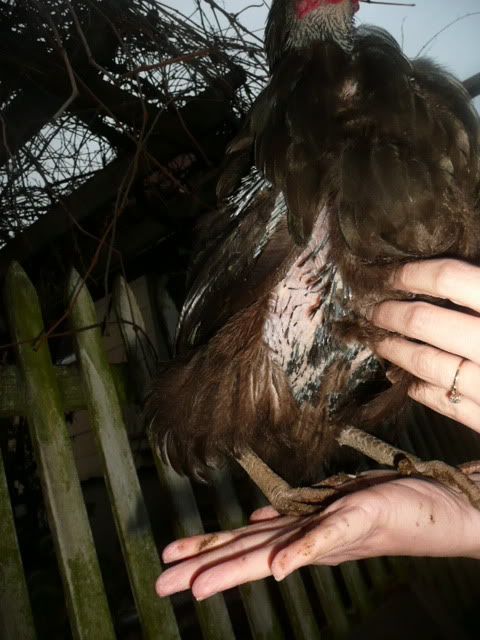I used up the last of our girls' eggs this morning. We're officially relegated to store-bought eggs until the ladies kick into gear again.
Last year we got no eggs from December until sometime in April. This year some of the girls starting molting in August, which was very early for them. I took it as a signal that our La Nina winter was to be very cold but thus far it's been fairly mild. I suppose we still have several months to go.
The cochin & Polish cresteds molted first, followed in close succession by the production birds. As was the case last year, the australorps (black hens) were the last to go. Also like last year, they look miserable: they're ratty and have broad swathes of bare skin in 40-degree weather. We've found, too, that our normally friendly birds shy away from being touched when they molt. It's got to be an uncomfortable process for them.
This is a pic I took of Croquette about this time last year (click link for more pics). She and Miss Piggy, our other australorp, look like this again now. Croquette has taken to standing in the middle of the yard, one leg pulled up to conserve heat, looking cranky. There's nothing we can do for her but offer our sympathy.
When Gene and I first got chickens a few years ago, we made the decision not to force them to lay during the winter. I'm rethinking that choice now, especially since they eat 50 pounds of feed each month at a cost of about $17. Freeloaders. Frankly, it's annoying to buy eggs at the grocery store when you know there's a flock of hens in your own yard.
So how come hens don't lay in the winter? If you think about it from a biological perspective, it makes perfect sense: it takes warmth and ample food to raise chicks. Neither of these things is available during the winter months so when the hours of daylight dwindle to less than 12 hours, hens' laying tapers off until it stops completely. As the hours increase in the spring, the production of eggs follows.
Modern chickens have been bred into two categories: ornamental and production. Ornamental birds, like our cochin and two Polish, tend to lay less frequently, go broody (i.e. desire to hatch eggs), and "switch off" for a longer period during the winter. Production birds, as the name implies, lay more eggs per week for more months of the year. Our nine-hen flock has six production birds: buff orpington, black star, Rhode Island Red, barred Plymouth Rock, and two australorps. They're the workhorses of the group. Other common ornamentals include "silkies" and others. Most of the birds you find in feed stores are production birds, though ornamentals are increasingly more common.
We've definitely seen the difference between our breeds. Beaker, one of our Polish cresteds, spent much of the summer trying to hatch the other girls' eggs or even sitting in an empty nesting box. When she finally quit being broody, she laid a half-dozen eggs, then molted. We'd get another standard cochin in a heartbeat - they're sweet, gentle, curious birds who don't mind being handled by children - but probably won't get any more Polish. The Polish are noisy, neurotic, and poor layers. That said, they're easy to catch because they can't see anything!
As an aside, we used to have a bantam cochin, who was also gentle with kids. Tribble's short legs, feathered feet, and our rainy climate meant that moisture wicked up onto her body all winter. She hated the rain and we constantly struggled with mite infestations on her.
Getting back to my point about laying cycles: it is possible to get the hens to lay during the winter. We've decided that the girls will get a much-needed break through December. They laid well last summer and we believe it's important to give their bodies a rest. Come the New Year, we're going to put lights in their coop to encourage production. Twelve to fourteen hours of light are needed to get them to lay. The sun sets around 4:30 p.m. here in January, so we'll turn on the light in the coop from 3:30 until 7:00 a.m., then allow the natural daylight to take over for the rest of the day. It's best to have the light in the morning to avoid the coop going dark before the girls have had a chance to get onto the roost.
Have you used supplemental lighting to encourage egg production in your backyard flock? How were your results?

I have been raising chickens for about 4 years and I am always learning new things. I do have quite a few friends that have been raising chickens longer than I have...chickens need about 14 hours of 'light' and plenty of food and water. My friends and I feed our chickens wheat screenings with oyster shell and of course food scraps, for example: fruit, vegis, meat (they need protein too), just about anything really. Most importantly is the hours of extra light you need to supplement. I currently have about 35 chickens and some have gone into a molt, and I still get about 18-24 eggs a day sometimes more. You can get one of those flourescent shop lights and a timer. Hope this helps :-)
ReplyDelete